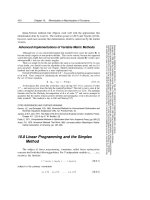KEY CONCEPTS & TECHNIQUES IN GIS Part 1 pps
Bạn đang xem bản rút gọn của tài liệu. Xem và tải ngay bản đầy đủ của tài liệu tại đây (111.25 KB, 13 trang )
KEY CONCEPTS & TECHNIQUES
IN GIS
Albrecht-3572-Prelims.qxd 7/13/2007 4:13 PM Page i
Albrecht-3572-Prelims.qxd 7/13/2007 4:13 PM Page ii
JOCHEN ALBRECHT
KEY CONCEPTS & TECHNIQUES IN GIS
Albrecht-3572-Prelims.qxd 7/13/2007 4:13 PM Page iii
© Jochen Albrecht 2007
First published 2007
Apart from any fair dealing for the purposes of research or
private study, or criticism or review, as permitted under the
Copyright, Designs and Patents Act, 1988, this publication may
be reproduced, stored or transmitted in any form, or by any
means, only with the prior permission in writing of the publishers,
or in the case of reprographic reproduction, in accordance with the
terms of licences issued by the Copyright Licensing Agency.
Enquiries concerning reproduction outside those terms should be
sent to the publishers.
SAGE Publications Ltd
1 Oliver’s Yard
55 City Road
London EC1Y 1SP
SAGE Publications Inc.
2455 Teller Road
Thousand Oaks, California 91320
SAGE Publications India Pvt Ltd
B1/I I Mohan Cooperative Industrial Area
Mathura Road, New Delhi 110 044
India
SAGE Publications Asia-Pacific Pte Ltd
33 Pekin Street #02-01
Far East Square
Singapore 048763
Library of Congress Control Number 2007922921
British Library Cataloguing in Publication data
A catalogue record for this book is available from
the British Library
ISBN 978-1-4129-1015-6
ISBN 978-1-4129-1016-3 (pbk)
Typeset by C&M Digitals (P) Ltd, Chennai, India
Printed and bound in Great Britain by TJ International Ltd
Printed on paper from sustainable resources
Albrecht-3572-Prelims.qxd 7/13/2007 4:13 PM Page iv
Contents
List of Figures ix
Preface xi
1 Creating Digital Data 1
1.1 Spatial data 2
1.2 Sampling 3
1.3 Remote sensing 5
1.4 Global positioning systems 7
1.5 Digitizing and scanning 8
1.6 The attribute component of geographic data 8
2 Accessing Existing Data 11
2.1 Data exchange 11
2.2 Conversion 12
2.3 Metadata 13
2.4 Matching geometries (projection and coordinate systems) 13
2.5 Geographic web services 15
3 Handling Uncertainty 17
3.1 Spatial data quality 17
3.2 How to handle data quality issues 19
4 Spatial Search 21
4.1 Simple spatial querying 21
4.2 Conditional querying 22
4.3 The query process 23
4.4 Selection 24
4.5 Background material: Boolean logic 25
5 Spatial Relationships 29
5.1 Recoding 29
5.2 Relationships between measurements 32
5.3 Relationships between features 34
Albrecht-3572-Prelims.qxd 7/13/2007 4:13 PM Page v
6 Combining Spatial Data 37
6.1 Overlay 37
6.2 Spatial Boolean logic 40
6.3 Buffers 41
6.4 Buffering in spatial search 43
6.5 Combining operations 43
6.6 Thiessen polygons 44
7 Location-Allocation 45
7.1 The best way 45
7.2 Gravity model 46
7.3 Location modeling 47
7.4 Allocation modeling 50
8 Map Algebra 51
8.1 Raster GIS 51
8.2 Local functions 53
8.3 Focal functions 55
8.4 Zonal functions 56
8.5 Global functions 57
8.6 Map algebra scripts 58
9 Terrain Modeling 59
9.1 Triangulated irregular networks (TINs) 60
9.2 Visibility analysis 61
9.3 Digital elevation and terrain models 62
9.4 Hydrological modeling 63
10 Spatial Statistics 65
10.1 Geo-statistics 65
10.1.1 Inverse distance weighting 65
10.1.2 Global and local polynomials 66
10.1.3 Splines 67
10.1.4 Kriging 69
10.2 Spatial analysis 70
10.2.1 Geometric descriptors 70
10.2.2 Spatial patterns 72
10.2.3 The modifiable area unit problem (MAUP) 74
10.2.4 Geographic relationships 75
vi CONTENTS
Albrecht-3572-Prelims.qxd 7/13/2007 4:13 PM Page vi
11 Geocomputation 77
11.1 Fuzzy reasoning 77
11.2 Neural networks 79
11.3 Genetic algorithms 80
11.4 Cellular automata 81
11.5 Agent-based modeling systems 82
12 Epilogue: Four-Dimensional Modeling 85
Glossary 89
References 95
Index 99
CONTENTS vii
Albrecht-3572-Prelims.qxd 7/13/2007 4:13 PM Page vii
Albrecht-3572-Prelims.qxd 7/13/2007 4:13 PM Page viii
List of Figures
Figure 1 Object vs. field view (vector vs. raster GIS) 3
Figure 2 Couclelis’ ‘Hierarchical Man’ 4
Figure 3 Illustration of variable source problem 5
Figure 4 Geographic relationships change according to scale 6
Figure 5 One geography but many different maps 12
Figure 6 Subset of a typical metadata tree 14
Figure 7 The effect of different projections 15
Figure 8 Simple query by location 22
Figure 9 Conditional query or query by (multiple) attributes 23
Figure 10 The relationship between spatial and attribute query 24
Figure 11 Partial and complete selection of features 25
Figure 12 Using one set of features to select another set 26
Figure 13 Simple Boolean logic operations 26
Figure 14 Typical soil map 30
Figure 15 Recoding as simplification 30
Figure 16 Recoding as a filter operation 31
Figure 17 Recoding to derive new information 31
Figure 18 Four possible spatial relationships in a pixel world 33
Figure 19 Simple (top row) and complex (bottom row) geometries 33
Figure 20 Pointer structure between tables of feature geometries 34
Figure 21 Part of the New York subway system 35
Figure 22 Topological relationships between features 35
Figure 23 Schematics of a polygon overlay operation 38
Figure 24 Overlay as a coincidence function 38
Figure 25 Overlay with multiple input layers 39
Figure 26 Spatial Boolean logic 40
Figure 27 The buffer operation in principle 41
Figure 28 Inward or inverse buffer 42
Figure 29 Corridor function 42
Figure 30 Surprise effects of buffering affecting towns
outside a flood zone 43
Figure 31 Thiessen polygons 44
Albrecht-3572-Prelims.qxd 7/13/2007 4:13 PM Page ix
Figure 32 Areas of influence determining the reach
of gravitational pull 47
Figure 33 Von Thünen’s agricultural zones around a market 48
Figure 34 Weber’s triangle 48
Figure 35 Christaller’s Central Place theory 49
Figure 36 Origin-destination matrix 50
Figure 37 The spatial scope of raster operations 52
Figure 38 Raster organization and cell position addressing 52
Figure 39 Zones of raster cells 53
Figure 40 Local function 54
Figure 41 Multiplication of a raster layer by a scalar 54
Figure 42 Multiplying one layer by another one 55
Figure 43 Focal function 55
Figure 44 Averaging neighborhood function 56
Figure 45 Zonal function 57
Figure 46 Value grids as spatial lookup tables 58
Figure 47 Three ways to represent the third dimension 59
Figure 48 Construction of a TIN 60
Figure 49 Viewshed 61
Figure 50 Derivation of slope and aspect 62
Figure 51 Flow accumulation map 63
Figure 52 Inverse distance weighting 66
Figure 53 Polynomials of first and second order 67
Figure 54 Local and global polynomials 67
Figure 55 Historical use of splines 68
Figure 56 Application of splines to surfaces 68
Figure 57 Exact and inexact interpolators 69
Figure 58 Geometric mean 71
Figure 59 Geometric mean and geometric median 72
Figure 60 Standard deviational ellipse 73
Figure 61 Shape measures 73
Figure 62 Joint count statistic 74
Figure 63 Shower tab illustrating fuzzy notions
of water temperature 78
Figure 64 Schematics of a single neuron 79
Figure 65 Genetic algorithms 81
Figure 66 Principles of genetic algorithms 82
x LIST OF FIGURES
Albrecht-3572-Prelims.qxd 7/13/2007 4:13 PM Page x
Preface
GIS has been coming of age. Millions of people use one GIS or another every day,
and with the advent of Web 2.0 we are promised GIS functionality on virtually every
desktop and web-enabled cellphone. GIS knowledge, once restricted to a few insid-
ers working with minicomputers that, as a category, don’t exist any more, has
proliferated and is bestowed on students at just about every university and increasingly
in community colleges and secondary schools. GIS textbooks abound and in the
course of 20 years have moved from specialized topics (Burrough 1986) to
general-purpose textbooks (Maantay and Ziegler 2006). With such a well-informed
user audience, who needs yet another book on GIS?
The answer is two-fold. First, while there are probably millions who use GIS,
there are far fewer who have had a systematic introduction to the topic. Many are
self-trained and good at the very small aspect of GIS they are doing on an everyday
basis, but they lack the bigger picture. Others have learned GIS somewhat system-
atically in school but were trained with a particular piece of software in mind – and
in any case were not made aware of modern methods and techniques. This book also
addresses decision-makers of all kinds – those who need to decide whether they
should invest in GIS or wait for GIS functionality in Google Earth (Virtual Earth if
you belong to the other camp).
This book is indebted to two role models. In the 1980s, Sage published a tremend-
ously useful series of little green paperbacks that reviewed quantitative methods,
mostly for the social sciences. They were concise, cheap (as in extremely good quality/
price ratio), and served students and practitioners alike. If this little volume that you
are now holding contributes to the revival of this series, then I consider my task to
be fulfilled. The other role model is an unsung hero, mostly because it served such
a small readership. The CATMOG (Concepts and Techniques in Modern
Geography) series fulfills the same set of criteria and I guess it is no coincidence that
it too has been published by Sage. CATMOG is now unfortunately out of print but
deserves to be promoted to the modern GIS audience at large, which as I pointed out
earlier, is just about everybody. With these two exemplars of the publishing pan-
theon in house, is it a wonder that I felt honored to be invited to write this volume?
My kudos goes to the unknown editors of these two series.
Jochen Albrecht
Albrecht-3572-Prelims.qxd 7/13/2007 4:13 PM Page xi
Albrecht-3572-Prelims.qxd 7/13/2007 4:13 PM Page xii









